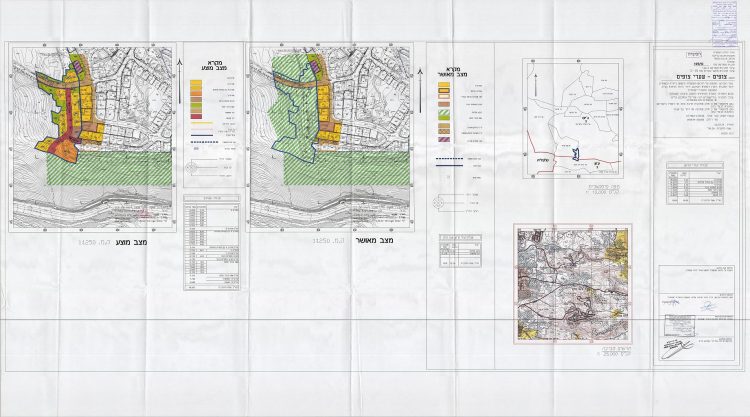On the 24th of August 2016, the Israeli Higher Planning Council of the so-called Israeli Civil Administration (ILA) advertised an announcement in the Palestinian daily newspaper, Al Quds, stating the designation of a new plan for settlement building on lands of Jayyus and Azzun villages northwest of Qalqilyia in the occupied West Bank. The publication was signed by Eng. Natalia Orbuch, head of the Israeli Settlement sub-committee at the Israeli Civil Administration in the occupied Palestinian territory, and declares the deposit of Town Planning Scheme (TPS) No. 149/10/יוש in Zufim Settlement (Sha’are Tzufim) in Qalqilyia Governorate, in the areas locally known by Kherbit Nofel and Al Thaher Al ‘Awaj. Below is a detailed description of the targeted lands in Azzun and Jayyus villages
- Basin No. 3: Kherbit Nofel and Al Lashleen, Jayyus village Lands
- Basin No. 2: , Al Thahr Al ‘Awaj, Azzun lands
- Sha’ae Tzufim, Shomron Regional council
Provisions of the plan as deposited come as follows:
- The plan declares Land Rezoning from agricultural to residential (Phase A) and for various application purposes: residential buildings and public facilities, public open spaces and roads.
- Changing the designation of an open public space and part of the proposed area (Phase A) for future expansion.
- Determination of various permissible land Uses.
- Outlining the various road network classification.
- Setting limits and provisions in the area with regard to construction plan.
- Determining conditions, stages of implementation and development phases required for the operational agency. Below is a copy of the posted Ad in Al Quds Daily Newspaper

Photo 1: The Announcement as posted in Al Quds daily newspaper
Referring to chapter No. 24(5),(6) of the Israeli City, Village, and Building Planning Law no. 79 of 1966, the Israeli settlement sub-committee declares the deposit of the Town Planning Scheme (TPS) No 149/10/ יוש in Zufim settlement (Sha’are Tzufim) as an amendment to the Regional plan No. S/15/ יוש and TPS No. 149/4/ יוש. The plan includes the building of 32 new settlement units on 18.5 dunums of lands of the aforementioned villages. For more information, see copies of the plan
Photos 2-4: Copies of TPS No. 149/10/ יוש in Sha’are Tzufim settlement
The plan comes into effect on the 7th of September 2016, 15 days from the date of publication in the newspaper.
Map 1: Location of the new neighborhood in Tzufim settlement
Zufim settlement at a glance,
Zufim settlement was established in 1990 on lands of Azzun and Jayyus villages. Today the settlement occupies an area of 642 dunums of the aforementioned communities where more than 1800 Israeli settlers live. To the west of the settlement, there is an Israeli military camp, named Tzufim camp, and administratively follows the settlement of Zufim.
The construction of the Israeli Segregation Wall in the occupied West Bank has created an isolation Zone along the western terrains of the West Bank, between the 1949 Armistice Line (Green Line) and the line of the wall. This zone is off access to Palestinians and it engulfs a cluster of Israeli settlements and outposts located in between including Tzufim settlement and the nearby military camp.
To conclude,
The continued construction of Israeli settlements on Palestinian land is killing off the prospects for a peace agreement between the Israelis and the Palestinians, as Israel spares no effort to build in Israeli settlements and extend its control over the Palestinian territory. At the same time, the Israeli government continues its policy of destruction of Palestinian homes and structures, land confiscations, and other policies against the will of the international community and contradict the Geneva convention and Hague regulations on human rights.
The first major document of international humanitarian law, The Hague Regulations of 1907, contains specific provisions outlawing Israel's colonization activities. The destruction of Palestinian civilian property and the seizure of Palestinian lands to build Israeli colonies, by-pass roads and the Segregation Wall is explicitly outlawed by Hague Convention IV, Article 23 (G), which clearly states that the occupying power is forbidden 'to destroy or seize the enemy's property, unless such destruction or seizure be imperatively demanded by the necessities of war.'
Israel's settlement program also violates the most important document of international humanitarian law – the Fourth Geneva Convention Relative to the Protection of Civilian Persons in a Time of War (hereinafter the Convention). In particular, Israel's settlements are built, and expanded, upon appropriated Palestinian land. The destruction of civilian property is prohibited by Article 53 of the Convention which states that: 'Any destruction by the Occupying Power of real or personal property belonging individually or collectively to private persons, or to the State, or to other public authorities, or to social or cooperative organizations, is prohibited, except where such destruction is rendered absolutely necessary by military operations.'
Article 147, moreover, defines 'extensive destruction and appropriation of property, not justified by military necessity and carried out unlawfully and wantonly' as a 'grave breach' of the Convention and defines these breaches as War Crimes. The High Contracting Parties (signatories) to the Convention are therefore required to 'enact any legislation necessary to provide effective penal sanctions' to stop Israel's colonization activities and prosecute Israeli officials in an international court.
Israel's settlement policy is also strictly forbidden by the Fourth Geneva Convention. In addition to violating the prescriptions against destruction to civilian property, Israel's program of populating the settlements with Jewish citizens violates Article 49 of the Convention which states that 'the occupying power shall not deport or transfer parts of its own population into the territories it occupies.'
Prepared By
The Applied Research Institute – Jerusalem
ARIJ


















